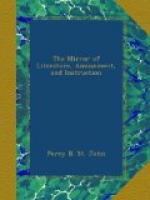ANCIENT PALACE OF HOLYROOD, AT EDINBURGH.
Here is another of the resting-places of fallen royalty; and a happy haven has it proved to many a crowned head; a retreat where the plain reproof of flattery—
How can you say to me,—I am a king?
would sound with melancholy sadness and truth.
The reader of “the age and body of the time” need not be told that the tenancy of Holyrood by the Ex-King of France has suggested its present introduction, although the Engraving represents the Palace about the year 1640. The structure, in connexion with the Chapel,[1] is thus described in Chambers’s Picture of Scotland, vol. ii. p. 61.
The Chapel and Palace of Holyrood are situated at the extremity of the suburb called the Cannongate. The ordinary phrase “the Abbey,” still popularly applied to both buildings, indicates that the former is the more ancient of the two. Like so many other religious establishments, it owns David I. for its founder. Erected in the twelfth century, and magnificently endowed by that monarch, it continued for about four centuries to flourish as an abbey, and to be, at least during the latter part of that time, the residence of the sovereign. In the year 1528, James V. added a palace to the conventual buildings. During the subsequent reign of Mary, this was the principal seat of the court; and so it continued in a great measure to be, till the departure of King James VI. for England. Previously to this period, the Abbey and Palace had suffered from fire, and they have since undergone such revolutions, that, as in the celebrated case of Sir John Cutler’s stockings, which, in the course of darning, changed nearly their whole substance, it is now scarcely possible to distinguish what is really ancient from the modern additions.
As they at present stand, the Palace is a handsome edifice, built in the form of a quadrangle, with a front flanked by double towers, while the Abbey is reduced from its originally extensive dimensions to the mere ruin of the chapel, one corner of which adjoins to a posterior angle of the Palace. Of the palatial structure, the north-west towers alone are old. The walls were certainly erected in the time of James V. They contain the apartments in which Queen Mary resided, and where her minion, Rizzio, fell a sacrifice to the revenge of her brutal husband. A certain portion of the furniture is of the time, and a still smaller portion is said to be the handiwork of that princess. The remaining parts of the structure were erected in the time of Charles ii. and have at no time been occupied by any royal personages, other than the Duke of York, Prince Charles Stuart, the Duke of Cumberland, the King of France, (in 1795-9,) and King George IV. in 1822. In the northern side of the quadrangle is a gallery one hundred and fifty feet in length, filled with the portraits of nearly as many imaginary Scottish kings. The south side




